A Christmas tradition in millions of American households is to curl up in front of a television set — and ideally a fireplace filled with crackling logs — and watch an old, black-and-white movie that never fails to rekindle the warm good feelings of the holiday.
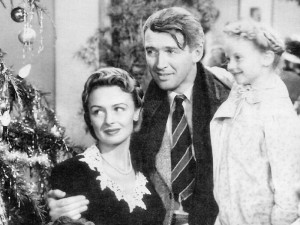
James Stewart as George Bailey — with Donna Reed as his wife, Mary, and Karolyn Grimes as his youngest child, Zulu — still looks frazzled, despite the happy ending to “It’s a Wonderful Life.” (Seneca Falls It’s a Wonderful Life Museum)
The 1946 movie classic, “It’s a Wonderful Life,” put together by legendary director Frank Capra, depicts a quaint, snow-covered town called “Bedford Falls.” If you dreamed up a quintessential American village, with orderly streets and houses and good-natured people living and working there, your vision would come close to describing Bedford Falls.
Capra never explained whether the make-believe town was inspired by one specific community or by a composite of wholesome small towns in the snowy northern United States.
But that hasn’t stopped little Seneca Falls, in upper New York state — already famous as the cradle of the American women’s-rights movement — from asserting a claim as the film’s likely inspiration.
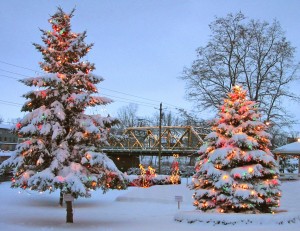
This isn’t the long, divided boulevard you see in Bedford Falls, but if Seneca Falls looked at all like this when Frank Capra visited, an idea might have formed. (Henry Law)
Frank Capra visited there a year before putting the film together. A barber, still living, remembers cutting his hair. And Capra likely came through Seneca Falls often on his frequent journeys to visit his aunt in the nearby larger city of Auburn, New York.
There’s a bridge in Seneca Falls that looks just like the one from which an angel in human form jumps to save the film’s hero, George Bailey. In fact, there’s an old plaque on that bridge — now called the “Bailey Bridge” — that Capra may have seen. It honors a young man who gave his life jumping into the canal below to save a woman who had leapt off the bridge in 1917.
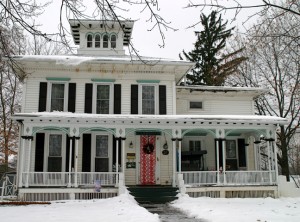
This is sort of how the Baileys’ house developed in the movie, but the film version was a wreck to start out. (Linda Solan)
There’s a house in town — check it out on the left — that is the spitting image, as my mother used to say, of the Bailey family home in the film. The train station looks just like Bedford Falls’s depot, too. There are also tombstones in Seneca Falls’s tiny cemetery carrying the names “Bailey” and “Martini” and “Partridge” — names that coincide with three prominent characters in “It’s a Wonderful Life.”
There’s a café in Seneca Falls named for George Bailey’s youngest daughter in the film. It’s called “Zuzu’s.” And Karolyn Grimes, the girl — now woman — who played Zuzu, comes to Seneca Falls every year. During a recent visit, on a day when the snow was falling in fat, wet flakes — unlike the dry fake snow that drifted onto Capra’s sound stage in Hollywood — she remarked that she was “home,” meaning, back in Bedford Falls.
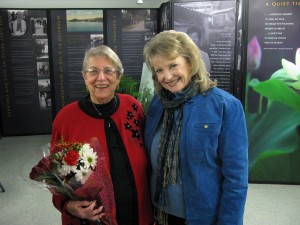
That’s grown-up Zuzu, Karolyn Grimes, on the right, with this year’s Bailey Award winner, 86-year-old Anita Awaduti. The award is presented by the IDEA Center for the Voices of Humanity, which shares the old Seneca Theater building with the new Seneca Falls It’s a Wonderful Life Museum. (Henry Law)
The folks in Seneca Falls believe so strongly that their village prompted Frank Capra to design a similar town for his movie that they throw an “It’s a Wonderful Life” celebration each December. The sixth such festival concluded last week. They have even just opened the “Seneca Falls It’s A Wonderful Life” museum in the historic Seneca Theater, right on Fall Street, the main avenue through town.
And when the once-grand Gould Hotel, which had declined and been converted into apartments, re-opened as a beautiful boutique hotel last year, it got a new name. Not “Bailey” or “Zuzu” or “Capra.” It’s now the “Hotel Clarence,” named for perhaps the most endearing figure in the “It’s a Wonderful Life” film. Clarence is a bumbling angel sent from heaven to earn his wings by performing a heroic deed. He does so by saving the despondent George Bailey after George’s suicidal plunge.
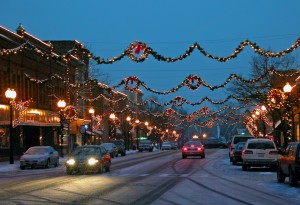
Now THIS could be Bedford Falls, if you could image this lovely holiday-season photo of Seneca Falls in black-and-white. (Henry Law)
According to the Seneca County Chamber of Commerce, “The theme of the beloved movie ‘It’s a Wonderful Life’ permeates every aspect of the hotel and reminds the traveler of times gone by.”
Times such as those experienced by Frank Capra himself in what a confident Seneca Falls Web site calls “the real Bedford Falls.”
Doubtless my friend and editor, Rob “Slice and Dice” Sivak — I was going to say “Butcher,” but humor columnist Gene Weingarten beat me to it in describing his editor’s sharp knife — would like me to stop this pleasant story here. But since I mentioned Seneca Falls’s importance as a women’s history center, I feel obliged to explain, if ever so briefly.
In the tiny farm town of Seneca Falls in 1848, 100 people — including 32 men — signed a Declaration of Sentiments demanding full and equal rights for women. The document borrowed heavily from the nation’s Declaration of Independence, with the emphatic addition of the female gender to those created equal. The document did not mince words about what it called “the absolute tyranny of man” over woman.
He has compelled her to submit to laws, in the formation of which she had no voice. . . . He has taken from her all right in property, even to the wages she earns. . . . He has endeavored, in every way that he could, to destroy her confidence in her own powers, to lessen her self-respect, and to make her willing to lead a dependent and abject life.
Now, in view of this entire disfranchisement of one-half the people of this country . . . we insist that they have immediate admission to all the rights and privileges which belong to them as citizens of the United States.
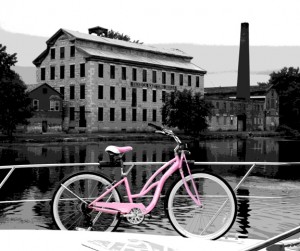
The landmark 1844-vintage Seneca Knitting Mill on the Cayuga-Seneca Canal is the future home of the National Women’s Hall of Fame. (Linda Solan)
Today in Seneca Falls, on the old Cayuga-Seneca Canal between the cities of Rochester and Syracuse, there’s a national park site that marks the Wesleyan Methodist Chapel, where those women’s-rights conventioneers — including suffragist pioneers Lucretia Mott and Elizabeth Cady Stanton — met 162 years ago. Ironically, two men chaired the meetings.
You’ll also find the National Women’s Hall of Fame in an old building on Fall Street.
And, fittingly, Seneca Falls has a woman mayor, though Diana Smith is the first woman to ever hold that job.
Her office is on State Street, not George Bailey Lane down the road.
Pity.
Ted's Wild Words
These are a few words from this posting that you may not know. Each time, I'll tell you a little about them and also place them into a cumulative archive of "Ted's Wild Words" in the right-hand column of the home page. Just click on it there, and if there's another word that you'd like me to explain, just ask!
Quintessential. Perfect, the epitome of something, as in “the quintessential southern mansion.”
Spitting image. A perfect likeness. The exact origin of this odd term is uncertain, but one theory dates it to the early American South, where syrupy accents were sometimes misunderstood by visitors. It’s thought that a common expression back then, “He’s the very spirit of his father,” was mistaken as “the very spit of his father.”


One response to “The Real Bedford Falls”
Ted,
Great article… with Christmas Spirit! It was definately a wonderful festival this year. It was ou 6th, I believe, not the 64th though. It is relatively new, but growing every year. It is always held on the second weekend of December. So many pleasant visitors came to Seneca Falls to enjoy the festivities. Our Radio Show by the Seneca Players was amazing. Very professional. Chilli and soup cook-offs, horse-drawn wagon rides, music at many venues, a fashion show and autograph signing by Karolyn Grimes. So much to do.
The visitors not only had fun with the “It’s A Wonderful Life” inspiration, but visited the many museums and learned about the industrial and canal history and the reform movement. For a small town, there is so much in Seneca Falls enjoy. Come see us at the Seneca Falls Visitor Center/Seneca Museum of waterways & Industry in the middle of downtown Seneca Falls. Say… Ted sent me!
Thanks Ted..
Linda Solan, Director